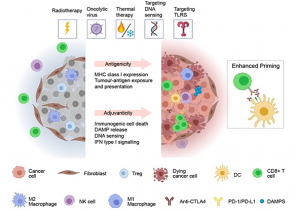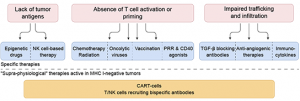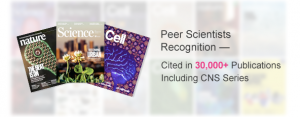20 Jun [MCE] Cold and Hot Tumors

With the advent of cancer immunotherapy and checkpoint inhibitors, significant progress has been made in targeting the host’s autoimmune response as an anticancer therapeutic intervention, transforming the oncology immunity and cancer treatment field. The unofficial classification of tumors into “cold tumors” and “hot tumors” based on tumor immune microenvironment has been developed. The hot tumor could induce a robust immune response to allow immune cells to attack tumor cells[1]. How could a cold tumor transformed into a hot tumor is a hot topic of tumor immunotherapy.
What is a hot and cold tumor?
Cold tumor: Also known as an immunodeficient tumor, a cold tumor is characterized by fewer CD8+ T cells in the tumor microenvironment (TME). Meanwhile, due to low mutation load, antigen presentation ability, and PD-L1 expression, cold tumors show little response to immune checkpoint inhibitors (ICIs)[2].
Hot tumor: Researchers often refer to immune-inflammatory tumors as hot tumors. Frequently accompanied by high T-cell infiltration, PD-L1 expression, and tumor mutational load (TMB), tumor cells can respond to ICI (immune checkpoint inhibitor) therapy[3].

Figure 1. Cold and hot tumors[4]
How to turn a cold tumor into a hot tumor?
T cell deficiency in cold tumors may be due to the following reasons: ①lack of tumor antigens, ②APCs deficit (Antigen Presenting Cells), ③absence of T cell priming/activation, ④impaired trafficking of T cells to the tumor mass[5]. According to the above factors, the corresponding treatment strategies to transform cold tumors into hot tumors will benefit patients[6,7]. For example, NK cell therapy, radiotherapy, chemotherapy, oncolytic virus therapy, vaccination, cytokine therapy, etc. (Figure 2).

Figure 2. Cold tumor treatment strategies[5]
MedChemExpress —
Master of Bioactive MoleculesMCE offers 20,000+ products and reagents for cancer research, including TME-related products.
| Product Name | Classification |
| BIO8898 Inhibitor |
BIO8898 is a potent CD40-CD154 inhibitor. |
| Mitazalimab Agonist |
Mitazalimab is a potent FcγR-dependent CD40 agonist. |
| TGFβ1-IN-1 Inhibitor |
TGFβ1-IN-1 is a potent, orally active TGF-β1 inhibitor. |
| SRI-011381 Agonist |
SRI-011381 hydrochloride is an orally active TGF-β signaling agonist. |
| PD-1-IN-18 Inhibitor |
PD-1-IN-18 is a PD1 signaling pathway inhibitor. |
| CL845 Agonist |
CL845 is an analog of the STING agonist CL656 (HY-112878). |
| TGF beta 1/TGFB1 protein Recombinant Protein |
TGF beta 1/TGFB1 protein inhibits the cell cycle in the G1 phase. |
| PD-1 protein Recombinant Protein |
PD-1 protein suppresses activating signals from the T cell receptor. |
| TMEM173 protein Recombinant Protein |
TMEM173 protein facilitates innate immune signaling. |
References
[1] Qianqian Duan et al.,Turning Cold into Hot: Firing up the Tumor Microenvironment. Trends in Cancer, 2020, 00467 No. of Pages 14.
[2] Wculek SK, Cueto FJ, Mujal AM, et al. Dendritic cells in cancer immunology and immunotherapy. Nat Rev Immunol. 2020;20:7-24.
[3] Wei C, Ma Y, Wang F, et al. Igniting Hope for Tumor Immunotherapy: Promoting the “Hot and Cold” Tumor Transition. Clin Med Insights Oncol. 2022 Sep 15;16:11795549221120708.
[4] Appleton E, Hassan J, Chan Wah Hak C, et al. Kickstarting Immunity in Cold Tumours: Localised Tumour Therapy Combinations With Immune Checkpoint Blockade. Front Immunol. 2021 Oct 18;12:754436.
[5] Bonaventura P, Shekarian T, Alcazer V, et al. Cold Tumors: A Therapeutic Challenge for Immunotherapy. Front Immunol. 2019 Feb 8;10:168.
[6] Tumeh PC, Harview CL, Yearley JH, et al. PD-1 blockade induces responses by inhibiting adaptive immune resistance. Nature. 2014;515(7528):568–571.
[7] Mi Y, Guo N, Luan J, et al. The emerging role of myeloid-derived suppressor cells in the glioma immune suppressive microenvironment. Front Immunol. 2020;11:737.

Request Your Quote


